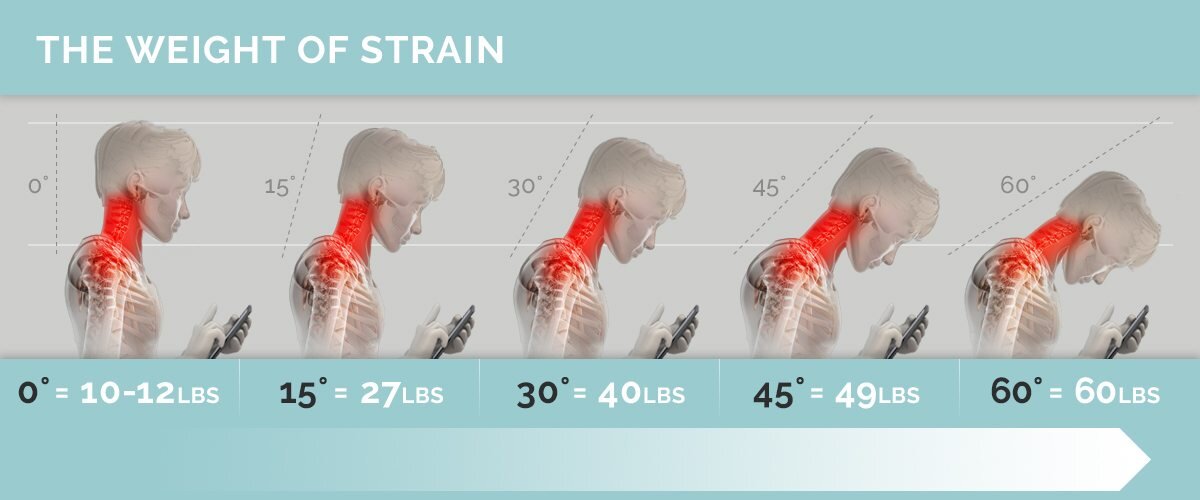Sitting in front of the computer isn’t a new phenomenon, but with the pandemic having us spend more of our time working, socializing, and scrolling the latest news on the screen (again and again), we all are spending longer hours with our laptops. This has made neck and upper back pain issues really take on a life of their own.
An upright, neutral position of the neck is an ideal posture for the health of your neck. But often we find ourselves bending our neck down and forward to look at our computer or phone screens. Studies have shown that humans have a reduced ability to maintain an upright cervical posture when distracted by computer tasks(1). This strains the neck muscles because the forward angle increases the load on the neck muscles, rather than using the cervical spine for support. I once had an acupuncture professor bring in a 8 lb sledge hammer to class to demonstrate the stress our 10-11 lb heads have on our necks when slightly bending forward. With each degree we moved the sledge hammer forward, the sledge hammer felt less stable and heavier. The professor's point was: moving our necks forward and down, even slightly, can cause significant muscular strain and heighten our neck pain.
A forward and downward angle of the neck can lead to an imbalance of the many muscles of the neck that wish to support and stabilize your head. Ultimately, this can lead to your upper back and posterior neck muscles getting stretched out and weakened. In turn this can lead to the front half of your neck muscles getting overly worked and tightened. This imbalance results in pain.
Studies have shown that ideally the deep muscles of the cervical spine- such as longus colli, semispinalis, and cervical multifidus- should mostly be supporting the cervical spine. Continuous forward motion of the neck, however, can impair activation of these deep flexor muscles and add more of a reliance on superficial flexor muscles in front of the neck, such as the sternocleidomastoid and anterior scalenes, which leads to these muscles getting tightened(1).
This postural imbalance can lead to your neck pain- and probably also to your tight upper back and shoulders, jaw pain, and tension headaches.
In Chinese medicine, we say that you should protect the neck. This is for many many reasons, including that many of the body’s meridians that circulate nutrients, blood, and warmth to the body all converge in the neck area. And this is where the cold, damp, windy weather of the winter can invade the neck and lead to impaired circulation of qi and blood to the local area, resulting in pain or sickness. This is probably why you have heard your local acupuncturist tell you to keep your neck covered with a warm scarf.
How to care for Neck Pain in the Age of Zoom:
Focus on Workplace Ergonomics at Home
Raise your screen so that it is at eye level so that you are not looking down and forward. There are plenty of laptop stands and bluetooth keyboards that offer an easy way to do this at home. A standing desk offers another option- with the goal of maintaining an upright, neutral position of the neck.
Other helpful postural cues - root your feet to the floor with weight distributed evenly, have your wrists supported by a desk and level with your elbows, and keep your hips and knees at the same level(2).
Take Breaks and Stretch!
All that soreness, pain, numbness, heavy sensation, and limited range of motion in the neck can commonly come from lack of circulation to the area. A quick way to counter that is by moving and stretching the body, every 30 to 60 minutes if you can! I often give patients 3 simple stretches to help open up the neck and chest to help realign their posture and maintain an upright, neutral position of the neck throughout their work day.
Nourish your Blood
In Chinese medicine the Liver opens to the eyes. When your eyes are glued to the screen for excessive amounts of time it can be very depleting to your Liver. In Chinese Medicine the Liver stores and regulated the blood, which has a direct effect on the tissues of the body being nourished and supple. When our muscles lack the nourishment of blood tightness, spasms and pain can result. Nourishing the blood is a therapeutic method your acupuncturist is often looking at when treating your neck pain. Quick ways to nourish your blood yourself are by incorporating nutritionally dense food such as beets, goji berries, dates, and bone broth into your diet. So take a healthy snack break (or a few) away from the screen daily.
Acupuncture and Body Work
Tension and adhesions in the neck muscles can be easily broken up with acupuncture and gentle massage techniques. The mechanisms that help acupuncture do this are by increasing local circulation throughout the area and stimulating local tissue changes, and by interacting with the nervous system to release neurotransmitters that promote pain modulation throughout the body. It is recommended that patients complete a series of 3-6 treatments for effective results for their neck pain, with more treatments needed for more chronic issues.
So simply put: take time to be aware of your posture while on the screen, set up a workspace that supports your neck health, take breaks to snack and stretch it out, and book an acupuncture session to help regulate and relieve your neck pain!
Falla D, Jull G, Russell T, Vicenzino B, Hodges P. Effect of neck exercise on sitting posture in patients with chronic neck pain. Phys Ther. 2007;87(4):408-17. doi: 10.2522/ptj.20060009. Epub 2007 Mar 6. PMID: 17341512.
Office Ergonomics: Your How-to Guide. MayoClinic.org. http://www.mayoclinic.org/healthy-lifestyle/adult-health/in-depth/office-ergonomics/art-20046169. Updated April 27, 2019. Accessed January 27, 2021.
First image from: https://www.flexjobs.com/blog/post/work-from-home-ergonomics-101/
Second image from: https://healthmatters.nyp.org/how-to-prevent-tech-neck/


